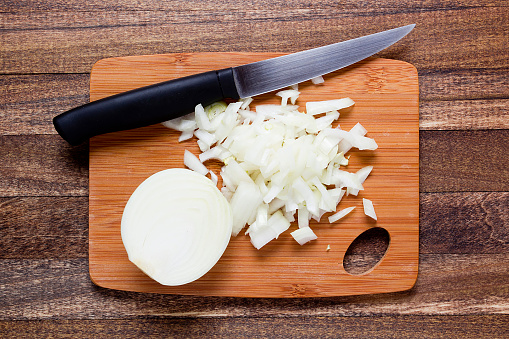
You’re prepping dinner, get to the “dice the onions” step….aaaaand cue the waterworks—every. time. You can thank the soil your key ingredient grew in: onions absorb sulfur from the earth into their cells. When you dice and slice, you break apart the onions’ cells, releasing enzymes and sulfur compounds that combine and react and form a gas called syn-propanethial-S-oxide. When this really irritating and even tougher to pronounce gas floats up and reaches your eyes, the burning sensation starts and tears flow. Don’t hate on the sulfur too much—it’s what gives onions some of their distinctive flavor.
We’ve heard a bunch of tear-free theories—some simple, others wacky. So we tried (and cried) five of the most popular to figure out what worked (and what absolutely did not). Here, the results:
1. CHILL BEFORE CHOPPING
The idea behind this method is that the compounds that irritate your eyes are less volatile when they’re cold; cooler molecules also move more slowly, so it takes longer for the gas to hit your face. We tried two versions of the chill-and-chop: refrigerating the onion for about 45 minutes and freezing for a half hour.
The verdict: Kind of works. There was still some stinging and tears, but less so than with the room-temp onion. And true to the theory, we got through chopping most of the onion before feeling the effects. A caveat: Unless you store your onions in the fridge, you’ll have to remember to stick them in or freeze beforehand so they’re ready when you need to prep.
We put our cutting board in the sink and let the water run while we chopped.
The verdict: It works! No tears and only a slight tinge, but also—not so easy. Its awkward and uncomfortable to chop in the sink (and under running water no less); plus, your onion pieces get a little water-logged, and you have to catch them before they float off the cutting board and into the dish drain. If you plan ahead, you could peel the outer layer of the onion and soak it in a bowl of water. We tried this too—soaking the peeled onion whole for about 15 minutes. The onion was a little slippery and the method didn’t work as well for us.
3. HOLD BREAD IN YOUR MOUTH
Yes, seriously. We read about this one a few times—the bread supposedly “soaks up” the gas before it hits your eyes—and figured why not give it a shot.
The verdict: Absolutely not. We tried holding a piece of sliced bread straight out to shield the tear-inducing sulfuric compounds, but then couldn’t see the cutting board. Tipping our head down to slice, the burning and tears commenced. We felt ridiculous, and ended up with a hunk of moist bread in our mouth.
Put your cutting board on a cool stovetop and turn on the oven or microwave vent fan to suck up the fumes. Or run a fan nearby to blow the gases away from your face.
The verdict: It mostly works! Our hood fan was set on high and though there was a little stinging, the tears were held at bay.
5. WEAR GOGGLES
They actually sell “onion goggles,” but we just grabbed our kids swim goggles, loosened the straps, and went to task.
The verdict: Totally works. You may look a little silly, but who cares—your eyes stay protected. If you wear glasses, however, keep those on and try other methods.
6. PREP WITH CANDLELIGHT
Not by candlelight—keep those overheads on please. But some suggest lighting a candle near your cutting board helps.
The verdict: It doesn’t. In fact, we felt like our eyes hurt more. But it did help mask the onion smell wafting through the kitchen.










